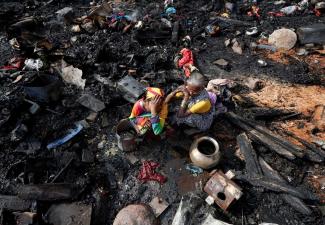Fire hazards
Nepal pays too little attention to fire hazards
 picture alliance / dpa / Narendra Shrestha
picture alliance / dpa / Narendra Shrestha
Nepal’s building safety code, updated in August 2020, focuses on making all types of structures resistant to earthquakes. The issue is important. In 2015, the 7.6-magnitude earthquake that struck near the capital Kathmandu killed about 9,000 people and injured many more. Moreover, the country suffered four quakes above magnitude 5.0 in 2021 alone, according to Volcano Discovery, an earthquake-tracking website.
Other hazards deserve attention too, however. Millions of Nepalis are vulnerable to fire risks in homes, factories, schools, hospitals and other buildings. The risks are compounded by lax regulation, poor enforcement of existing rules, inadequate zoning controls and deficient infrastructure (regarding waste management see Roshan Sharma’s 2016 essay on www.dandc.eu).
“Though the impact of fire hazards in Nepal is significant, fires are overlooked in our policy and disaster management,” stated an editorial in The Himalayan Times in March, 2021. Nepal’s leading English-language newspaper went on to argue: “None of the municipalities have a fire response, contingency, fire safety or emergency plan.”
Fires are a constant threat. Blazes make headlines regularly – and many fires are not reported by the media. When buildings burn, people often die (see box). Things are similar in many countries marked by poverty and fast urban growth.
Flocking to cities
The background to Nepal’s fire hazard is its rapid and haphazard urbanisation, combined with fast population growth. Nepal is one of Asia’s most rapidly urbanising countries. Today, about two thirds of Nepal’s people live in cities, according to preliminary 2021 census figures. Their ranks are growing steadily as yet more people migrate to urban areas in search of work and easier lifestyles.
Urban infrastructure is not keeping up with the influx. Roads in many areas are narrow and in poor condition, making access difficult for rescue vehicles. A shortage of affordable and safe urban housing causes many new arrivals to live in makeshift squatter settlements. Dwellings there are often made with substandard materials and lack fire-safety equipment such as smoke detectors, fire alarms and fire extinguishers. As is true across South Asia, blazes in slum areas can be devastating.
At the same time, cities including Kathmandu are seeing a surge in new of high-rise office buildings, as well as apartment buildings and malls. All too many of them do not comply with building safety regulations.
Furthermore, cities are not properly zoned with separate areas for houses, hospitals, schools and industrial estates. This creates additional safety concerns. For instance, over 100 petrol pumps are situated in densely populated residential areas, without proper fire safeguards. Proper urban planning would help to control the risks and improve people’s way of life life (see Katie Cashman on www.dandc.eu).
Building codes
To mitigate some risks pertaining to individual houses and structures, the government issued a building code in 1994. It has been updated several times since then. The original code set rules for structures of up to three storeys. Later updates of the code set rules for taller buildings as well. Among other things, the rules aim to shore up safety in high-rise buildings and in the hundreds of thousands of reinforced-concrete houses that sprang up across the country in recent decades.
For example, the 2015 architectural design update requires, among other things, that commercial buildings must have adequate emergency exits. They also must have fire alarms, fire extinguishers and access for the disabled. Buildings with more than five storeys should have fire escapes leading out to open spaces. Local regulations add further requirements, for example setting maximum building heights depending on the type of neighbourhood, and setting minimum ratios of floor area to building height.
Poor enforcement
The set of formal rules makes sense. In practice, hazards remain however. In January 2021, for example, people were trapped in a burning high-rise building in Kathmandu. Persons outside wanted to help them, but they could not open emergency doors. They had been designed to open only from the inside. The building had been built before a new rule was passed which spelled out that it must be possible to open doors from both sides, but it did not require owners to bring older buildings into compliance. Most likely, other skyscrapers in Kathmandu also fail to meet the code’s current standards.
Formal safety rules may actually give city dwellers a false sense of security. They know that a permit system is in place. Builders must get one from a local authority before they start construction. And since the financial year 2000/2001, they must also get a safety certificate from that authority after construction is completed. However, it is not illegal for people to move into a building before it is completed. It is common – and risky – for people to move in to lower-floor flats of apartment complexes while upper floors are still being built.
The problem is that these rules are often ignored. In August 2021, a devastating fire broke out in an industrial estate in Kathmandu. It took more than 10 hours to bring the fire under control. Property worth millions of dollars was destroyed.
This incident raised questions about the building’s safety. It was reported that some workers suspected some buildings had wiring defects and electric materials of poor quality, creating a risk of electric short circuits.
In general, it is easy in Nepal to get a safety certificate by applying political influence or paying a bribe. It is also easy to bypass regulations. For example, there are cases in which developers got a permit for a 2.5 storey building and then built a five-storey structure with impunity. It is common for Nepalis to build houses with no permit at all. Unless local authorities receive a formal complaint they cannot take action against a builder or the owner. Such buildings remain standing. They often are accidents waiting to happen.
To reduce such risks, government agencies at national, province and local levels should run safety awareness campaigns, involving builders, building owners and residents’ groups. The authorities would do well to strengthen existing building codes, enforce rules and upgrade infrastructure so that fires can be put out quickly. Competent action of this kind will prevent harm and save lives.
Rukamanee Maharjan is an assistant professor of law at Tribhuvan University, Kathmandu.
rukumaharjan@gmail.com

